Principles of Sustainability: Climate Change Impacts on Sydney
VerifiedAdded on 2019/10/30
|11
|2605
|251
Report
AI Summary
This report analyzes the predicted impacts of climate change on Sydney, Australia, focusing on the effects on precipitation, sea level, humidity, wind, and temperature. It details the impact on water resources, including reduced water storage and increased salinity, and the effects on agriculture, such as reduced crop diversity and social conflicts over water distribution. The report also explores the social impacts, including health effects and potential for political disturbances due to refugee movements and water scarcity. It provides projections for the years 2030, 2050, and 2100, and discusses the adaptation strategies in place to mitigate these impacts. The report highlights Sydney's vulnerability as a coastal city and its increasing population, emphasizing the need for proactive measures to address the challenges posed by climate change.
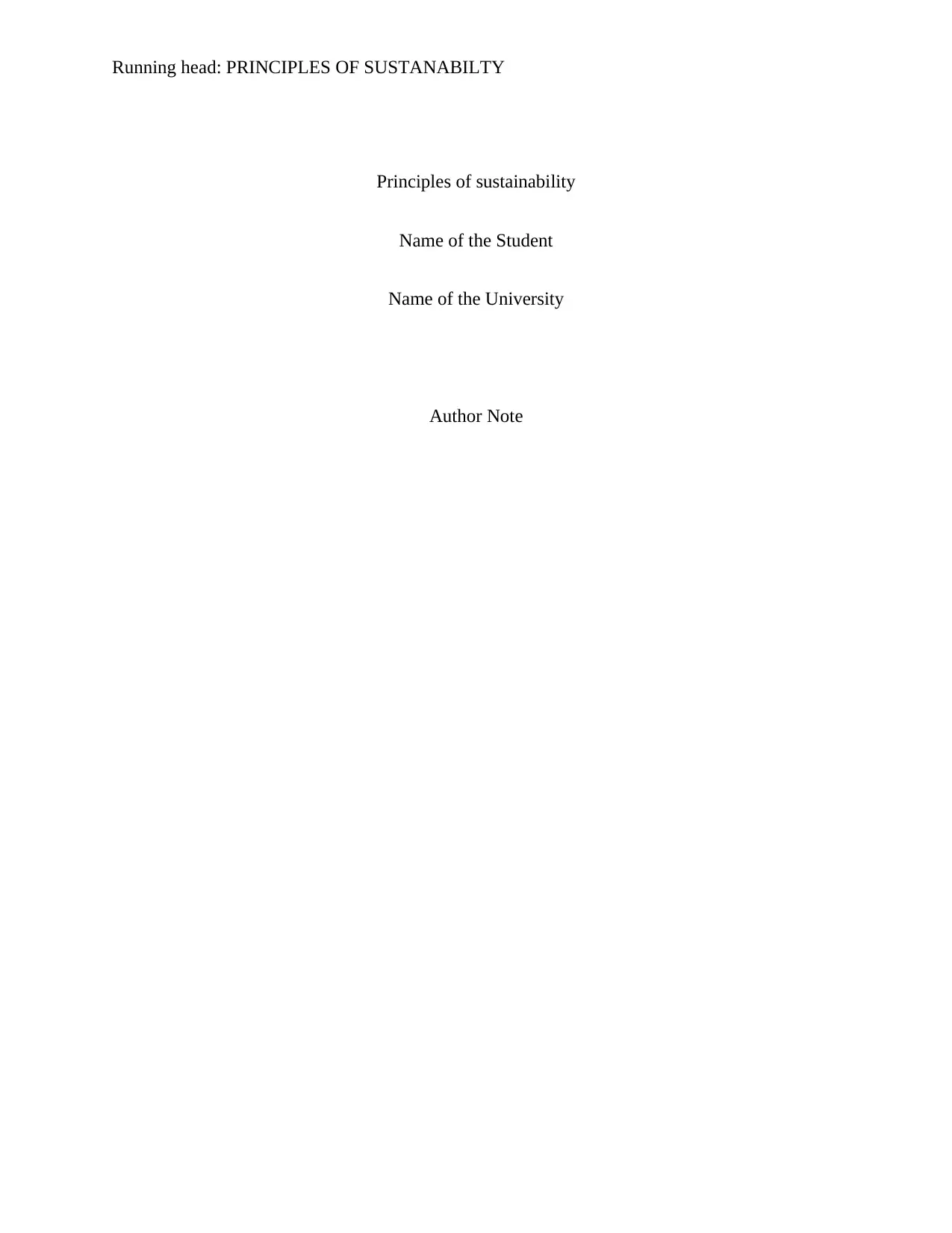
Running head: PRINCIPLES OF SUSTANABILTY
Principles of sustainability
Name of the Student
Name of the University
Author Note
Principles of sustainability
Name of the Student
Name of the University
Author Note
Paraphrase This Document
Need a fresh take? Get an instant paraphrase of this document with our AI Paraphraser
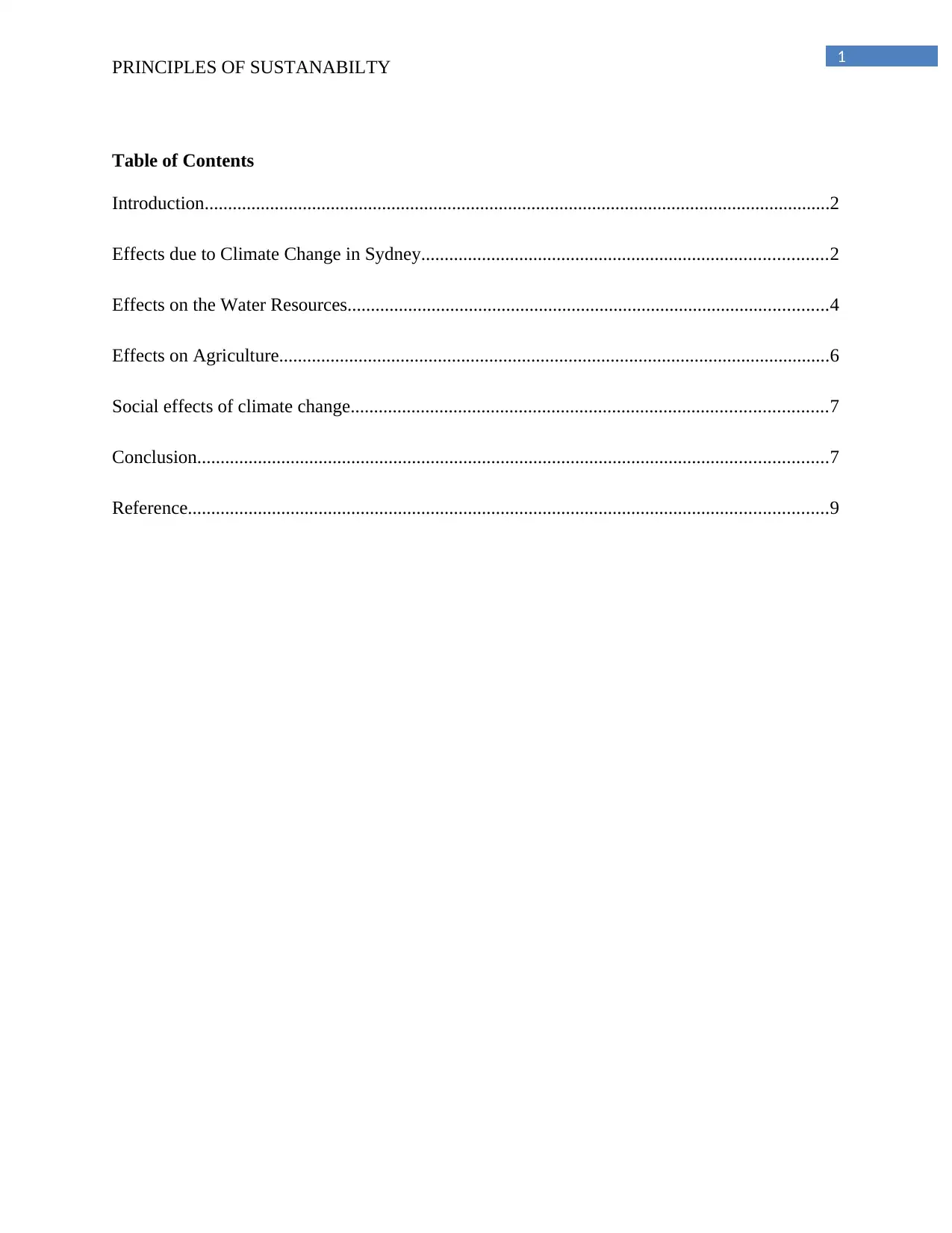
1
PRINCIPLES OF SUSTANABILTY
Table of Contents
Introduction......................................................................................................................................2
Effects due to Climate Change in Sydney.......................................................................................2
Effects on the Water Resources.......................................................................................................4
Effects on Agriculture......................................................................................................................6
Social effects of climate change......................................................................................................7
Conclusion.......................................................................................................................................7
Reference.........................................................................................................................................9
PRINCIPLES OF SUSTANABILTY
Table of Contents
Introduction......................................................................................................................................2
Effects due to Climate Change in Sydney.......................................................................................2
Effects on the Water Resources.......................................................................................................4
Effects on Agriculture......................................................................................................................6
Social effects of climate change......................................................................................................7
Conclusion.......................................................................................................................................7
Reference.........................................................................................................................................9
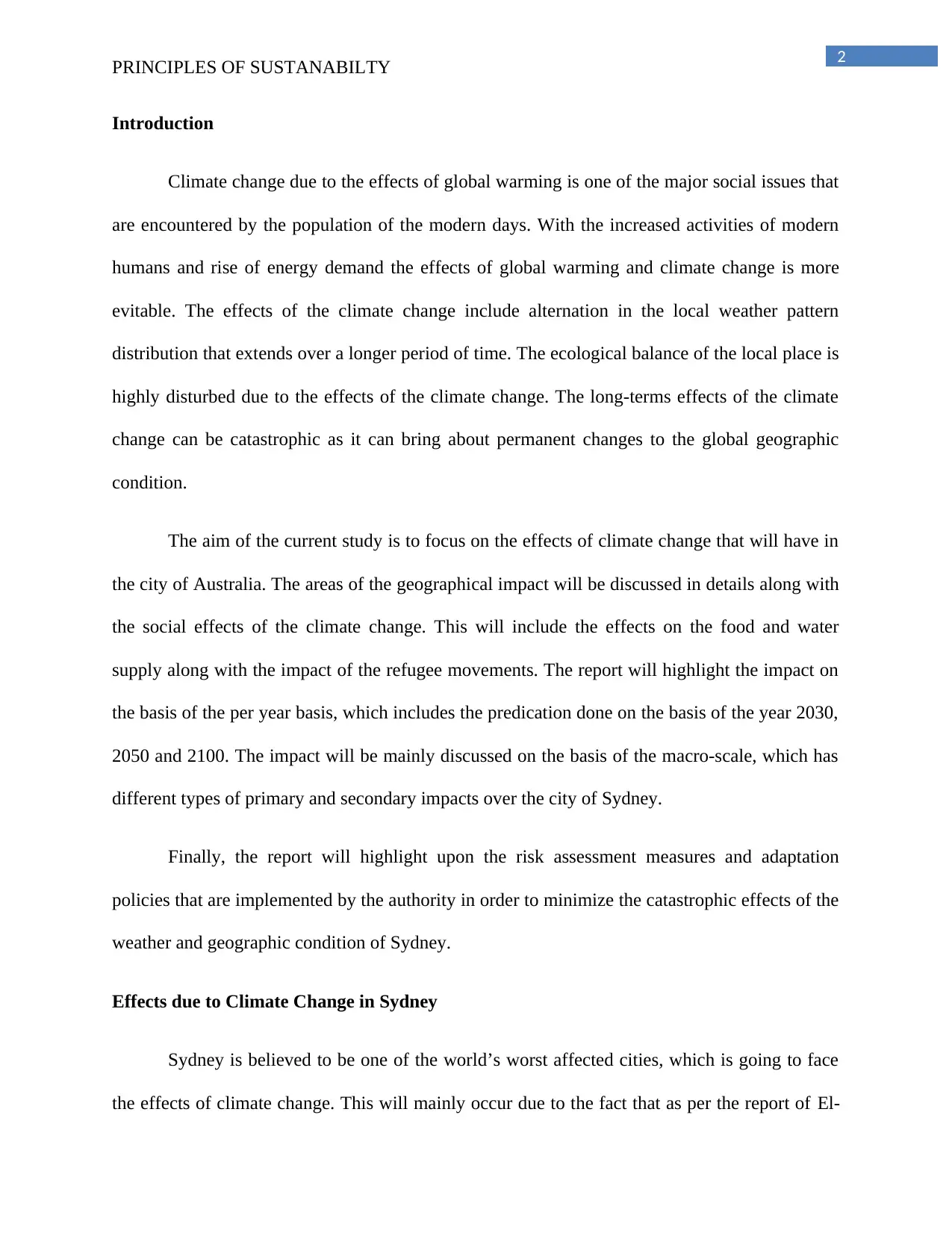
2
PRINCIPLES OF SUSTANABILTY
Introduction
Climate change due to the effects of global warming is one of the major social issues that
are encountered by the population of the modern days. With the increased activities of modern
humans and rise of energy demand the effects of global warming and climate change is more
evitable. The effects of the climate change include alternation in the local weather pattern
distribution that extends over a longer period of time. The ecological balance of the local place is
highly disturbed due to the effects of the climate change. The long-terms effects of the climate
change can be catastrophic as it can bring about permanent changes to the global geographic
condition.
The aim of the current study is to focus on the effects of climate change that will have in
the city of Australia. The areas of the geographical impact will be discussed in details along with
the social effects of the climate change. This will include the effects on the food and water
supply along with the impact of the refugee movements. The report will highlight the impact on
the basis of the per year basis, which includes the predication done on the basis of the year 2030,
2050 and 2100. The impact will be mainly discussed on the basis of the macro-scale, which has
different types of primary and secondary impacts over the city of Sydney.
Finally, the report will highlight upon the risk assessment measures and adaptation
policies that are implemented by the authority in order to minimize the catastrophic effects of the
weather and geographic condition of Sydney.
Effects due to Climate Change in Sydney
Sydney is believed to be one of the world’s worst affected cities, which is going to face
the effects of climate change. This will mainly occur due to the fact that as per the report of El-
PRINCIPLES OF SUSTANABILTY
Introduction
Climate change due to the effects of global warming is one of the major social issues that
are encountered by the population of the modern days. With the increased activities of modern
humans and rise of energy demand the effects of global warming and climate change is more
evitable. The effects of the climate change include alternation in the local weather pattern
distribution that extends over a longer period of time. The ecological balance of the local place is
highly disturbed due to the effects of the climate change. The long-terms effects of the climate
change can be catastrophic as it can bring about permanent changes to the global geographic
condition.
The aim of the current study is to focus on the effects of climate change that will have in
the city of Australia. The areas of the geographical impact will be discussed in details along with
the social effects of the climate change. This will include the effects on the food and water
supply along with the impact of the refugee movements. The report will highlight the impact on
the basis of the per year basis, which includes the predication done on the basis of the year 2030,
2050 and 2100. The impact will be mainly discussed on the basis of the macro-scale, which has
different types of primary and secondary impacts over the city of Sydney.
Finally, the report will highlight upon the risk assessment measures and adaptation
policies that are implemented by the authority in order to minimize the catastrophic effects of the
weather and geographic condition of Sydney.
Effects due to Climate Change in Sydney
Sydney is believed to be one of the world’s worst affected cities, which is going to face
the effects of climate change. This will mainly occur due to the fact that as per the report of El-
⊘ This is a preview!⊘
Do you want full access?
Subscribe today to unlock all pages.

Trusted by 1+ million students worldwide
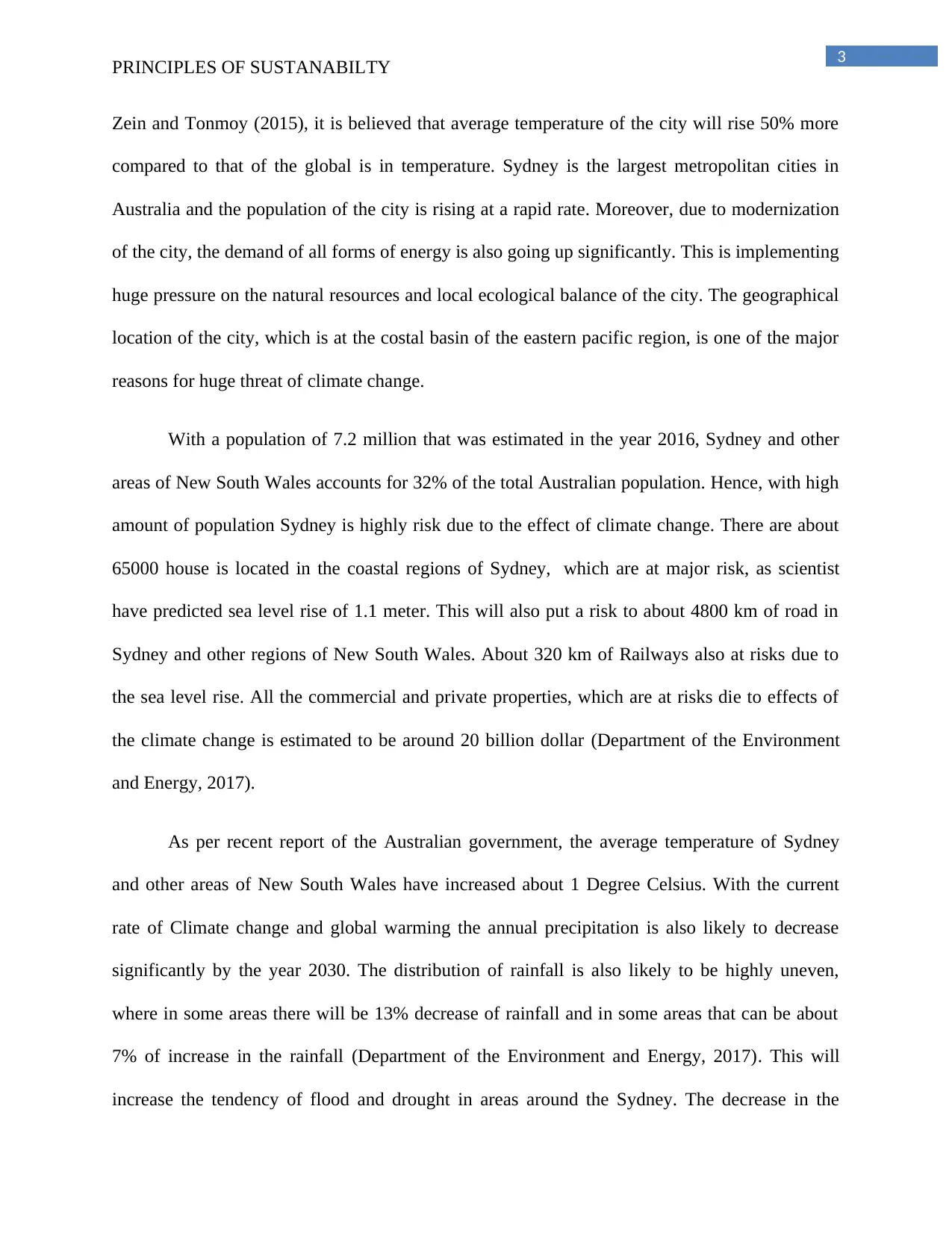
3
PRINCIPLES OF SUSTANABILTY
Zein and Tonmoy (2015), it is believed that average temperature of the city will rise 50% more
compared to that of the global is in temperature. Sydney is the largest metropolitan cities in
Australia and the population of the city is rising at a rapid rate. Moreover, due to modernization
of the city, the demand of all forms of energy is also going up significantly. This is implementing
huge pressure on the natural resources and local ecological balance of the city. The geographical
location of the city, which is at the costal basin of the eastern pacific region, is one of the major
reasons for huge threat of climate change.
With a population of 7.2 million that was estimated in the year 2016, Sydney and other
areas of New South Wales accounts for 32% of the total Australian population. Hence, with high
amount of population Sydney is highly risk due to the effect of climate change. There are about
65000 house is located in the coastal regions of Sydney, which are at major risk, as scientist
have predicted sea level rise of 1.1 meter. This will also put a risk to about 4800 km of road in
Sydney and other regions of New South Wales. About 320 km of Railways also at risks due to
the sea level rise. All the commercial and private properties, which are at risks die to effects of
the climate change is estimated to be around 20 billion dollar (Department of the Environment
and Energy, 2017).
As per recent report of the Australian government, the average temperature of Sydney
and other areas of New South Wales have increased about 1 Degree Celsius. With the current
rate of Climate change and global warming the annual precipitation is also likely to decrease
significantly by the year 2030. The distribution of rainfall is also likely to be highly uneven,
where in some areas there will be 13% decrease of rainfall and in some areas that can be about
7% of increase in the rainfall (Department of the Environment and Energy, 2017). This will
increase the tendency of flood and drought in areas around the Sydney. The decrease in the
PRINCIPLES OF SUSTANABILTY
Zein and Tonmoy (2015), it is believed that average temperature of the city will rise 50% more
compared to that of the global is in temperature. Sydney is the largest metropolitan cities in
Australia and the population of the city is rising at a rapid rate. Moreover, due to modernization
of the city, the demand of all forms of energy is also going up significantly. This is implementing
huge pressure on the natural resources and local ecological balance of the city. The geographical
location of the city, which is at the costal basin of the eastern pacific region, is one of the major
reasons for huge threat of climate change.
With a population of 7.2 million that was estimated in the year 2016, Sydney and other
areas of New South Wales accounts for 32% of the total Australian population. Hence, with high
amount of population Sydney is highly risk due to the effect of climate change. There are about
65000 house is located in the coastal regions of Sydney, which are at major risk, as scientist
have predicted sea level rise of 1.1 meter. This will also put a risk to about 4800 km of road in
Sydney and other regions of New South Wales. About 320 km of Railways also at risks due to
the sea level rise. All the commercial and private properties, which are at risks die to effects of
the climate change is estimated to be around 20 billion dollar (Department of the Environment
and Energy, 2017).
As per recent report of the Australian government, the average temperature of Sydney
and other areas of New South Wales have increased about 1 Degree Celsius. With the current
rate of Climate change and global warming the annual precipitation is also likely to decrease
significantly by the year 2030. The distribution of rainfall is also likely to be highly uneven,
where in some areas there will be 13% decrease of rainfall and in some areas that can be about
7% of increase in the rainfall (Department of the Environment and Energy, 2017). This will
increase the tendency of flood and drought in areas around the Sydney. The decrease in the
Paraphrase This Document
Need a fresh take? Get an instant paraphrase of this document with our AI Paraphraser
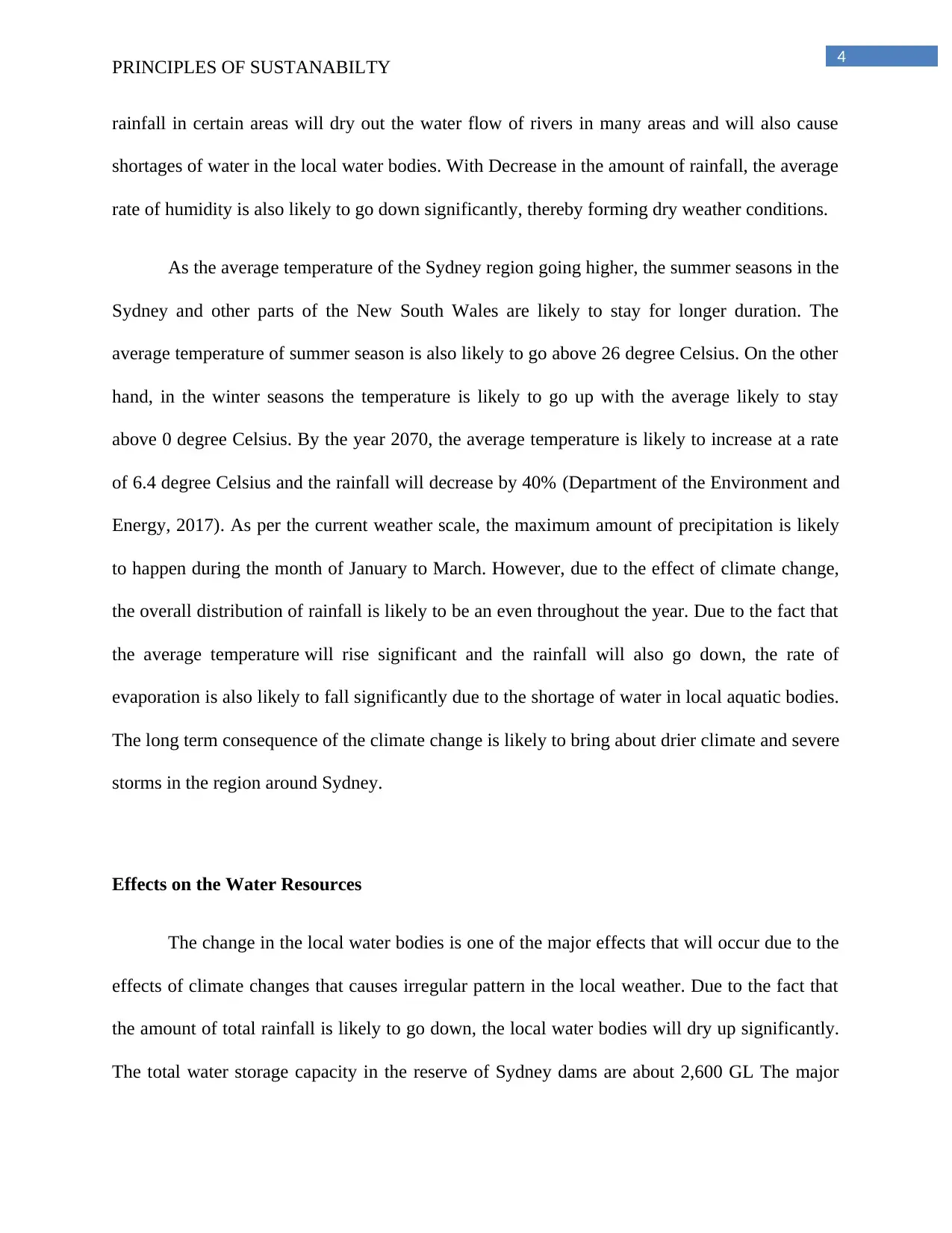
4
PRINCIPLES OF SUSTANABILTY
rainfall in certain areas will dry out the water flow of rivers in many areas and will also cause
shortages of water in the local water bodies. With Decrease in the amount of rainfall, the average
rate of humidity is also likely to go down significantly, thereby forming dry weather conditions.
As the average temperature of the Sydney region going higher, the summer seasons in the
Sydney and other parts of the New South Wales are likely to stay for longer duration. The
average temperature of summer season is also likely to go above 26 degree Celsius. On the other
hand, in the winter seasons the temperature is likely to go up with the average likely to stay
above 0 degree Celsius. By the year 2070, the average temperature is likely to increase at a rate
of 6.4 degree Celsius and the rainfall will decrease by 40% (Department of the Environment and
Energy, 2017). As per the current weather scale, the maximum amount of precipitation is likely
to happen during the month of January to March. However, due to the effect of climate change,
the overall distribution of rainfall is likely to be an even throughout the year. Due to the fact that
the average temperature will rise significant and the rainfall will also go down, the rate of
evaporation is also likely to fall significantly due to the shortage of water in local aquatic bodies.
The long term consequence of the climate change is likely to bring about drier climate and severe
storms in the region around Sydney.
Effects on the Water Resources
The change in the local water bodies is one of the major effects that will occur due to the
effects of climate changes that causes irregular pattern in the local weather. Due to the fact that
the amount of total rainfall is likely to go down, the local water bodies will dry up significantly.
The total water storage capacity in the reserve of Sydney dams are about 2,600 GL The major
PRINCIPLES OF SUSTANABILTY
rainfall in certain areas will dry out the water flow of rivers in many areas and will also cause
shortages of water in the local water bodies. With Decrease in the amount of rainfall, the average
rate of humidity is also likely to go down significantly, thereby forming dry weather conditions.
As the average temperature of the Sydney region going higher, the summer seasons in the
Sydney and other parts of the New South Wales are likely to stay for longer duration. The
average temperature of summer season is also likely to go above 26 degree Celsius. On the other
hand, in the winter seasons the temperature is likely to go up with the average likely to stay
above 0 degree Celsius. By the year 2070, the average temperature is likely to increase at a rate
of 6.4 degree Celsius and the rainfall will decrease by 40% (Department of the Environment and
Energy, 2017). As per the current weather scale, the maximum amount of precipitation is likely
to happen during the month of January to March. However, due to the effect of climate change,
the overall distribution of rainfall is likely to be an even throughout the year. Due to the fact that
the average temperature will rise significant and the rainfall will also go down, the rate of
evaporation is also likely to fall significantly due to the shortage of water in local aquatic bodies.
The long term consequence of the climate change is likely to bring about drier climate and severe
storms in the region around Sydney.
Effects on the Water Resources
The change in the local water bodies is one of the major effects that will occur due to the
effects of climate changes that causes irregular pattern in the local weather. Due to the fact that
the amount of total rainfall is likely to go down, the local water bodies will dry up significantly.
The total water storage capacity in the reserve of Sydney dams are about 2,600 GL The major
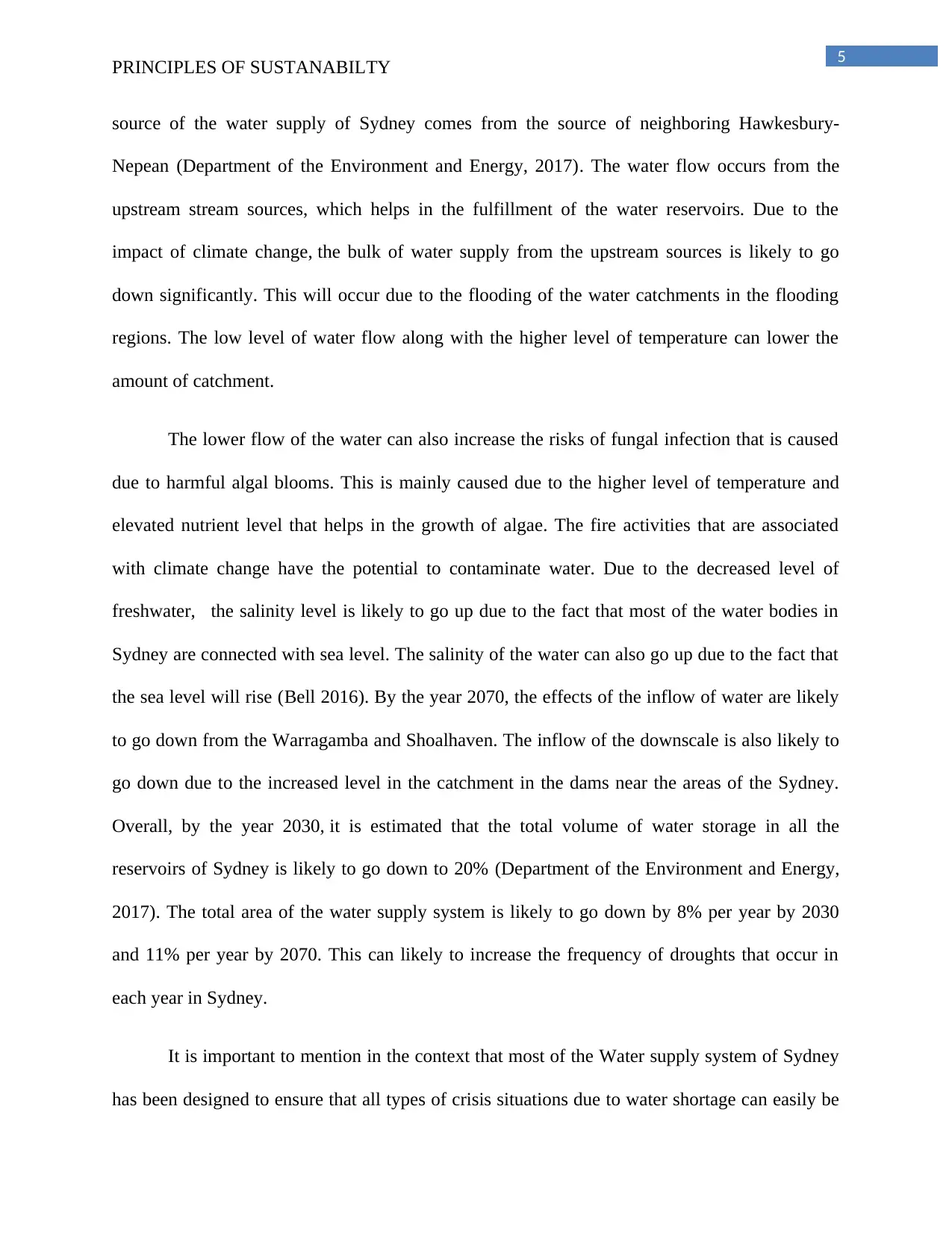
5
PRINCIPLES OF SUSTANABILTY
source of the water supply of Sydney comes from the source of neighboring Hawkesbury-
Nepean (Department of the Environment and Energy, 2017). The water flow occurs from the
upstream stream sources, which helps in the fulfillment of the water reservoirs. Due to the
impact of climate change, the bulk of water supply from the upstream sources is likely to go
down significantly. This will occur due to the flooding of the water catchments in the flooding
regions. The low level of water flow along with the higher level of temperature can lower the
amount of catchment.
The lower flow of the water can also increase the risks of fungal infection that is caused
due to harmful algal blooms. This is mainly caused due to the higher level of temperature and
elevated nutrient level that helps in the growth of algae. The fire activities that are associated
with climate change have the potential to contaminate water. Due to the decreased level of
freshwater, the salinity level is likely to go up due to the fact that most of the water bodies in
Sydney are connected with sea level. The salinity of the water can also go up due to the fact that
the sea level will rise (Bell 2016). By the year 2070, the effects of the inflow of water are likely
to go down from the Warragamba and Shoalhaven. The inflow of the downscale is also likely to
go down due to the increased level in the catchment in the dams near the areas of the Sydney.
Overall, by the year 2030, it is estimated that the total volume of water storage in all the
reservoirs of Sydney is likely to go down to 20% (Department of the Environment and Energy,
2017). The total area of the water supply system is likely to go down by 8% per year by 2030
and 11% per year by 2070. This can likely to increase the frequency of droughts that occur in
each year in Sydney.
It is important to mention in the context that most of the Water supply system of Sydney
has been designed to ensure that all types of crisis situations due to water shortage can easily be
PRINCIPLES OF SUSTANABILTY
source of the water supply of Sydney comes from the source of neighboring Hawkesbury-
Nepean (Department of the Environment and Energy, 2017). The water flow occurs from the
upstream stream sources, which helps in the fulfillment of the water reservoirs. Due to the
impact of climate change, the bulk of water supply from the upstream sources is likely to go
down significantly. This will occur due to the flooding of the water catchments in the flooding
regions. The low level of water flow along with the higher level of temperature can lower the
amount of catchment.
The lower flow of the water can also increase the risks of fungal infection that is caused
due to harmful algal blooms. This is mainly caused due to the higher level of temperature and
elevated nutrient level that helps in the growth of algae. The fire activities that are associated
with climate change have the potential to contaminate water. Due to the decreased level of
freshwater, the salinity level is likely to go up due to the fact that most of the water bodies in
Sydney are connected with sea level. The salinity of the water can also go up due to the fact that
the sea level will rise (Bell 2016). By the year 2070, the effects of the inflow of water are likely
to go down from the Warragamba and Shoalhaven. The inflow of the downscale is also likely to
go down due to the increased level in the catchment in the dams near the areas of the Sydney.
Overall, by the year 2030, it is estimated that the total volume of water storage in all the
reservoirs of Sydney is likely to go down to 20% (Department of the Environment and Energy,
2017). The total area of the water supply system is likely to go down by 8% per year by 2030
and 11% per year by 2070. This can likely to increase the frequency of droughts that occur in
each year in Sydney.
It is important to mention in the context that most of the Water supply system of Sydney
has been designed to ensure that all types of crisis situations due to water shortage can easily be
⊘ This is a preview!⊘
Do you want full access?
Subscribe today to unlock all pages.

Trusted by 1+ million students worldwide
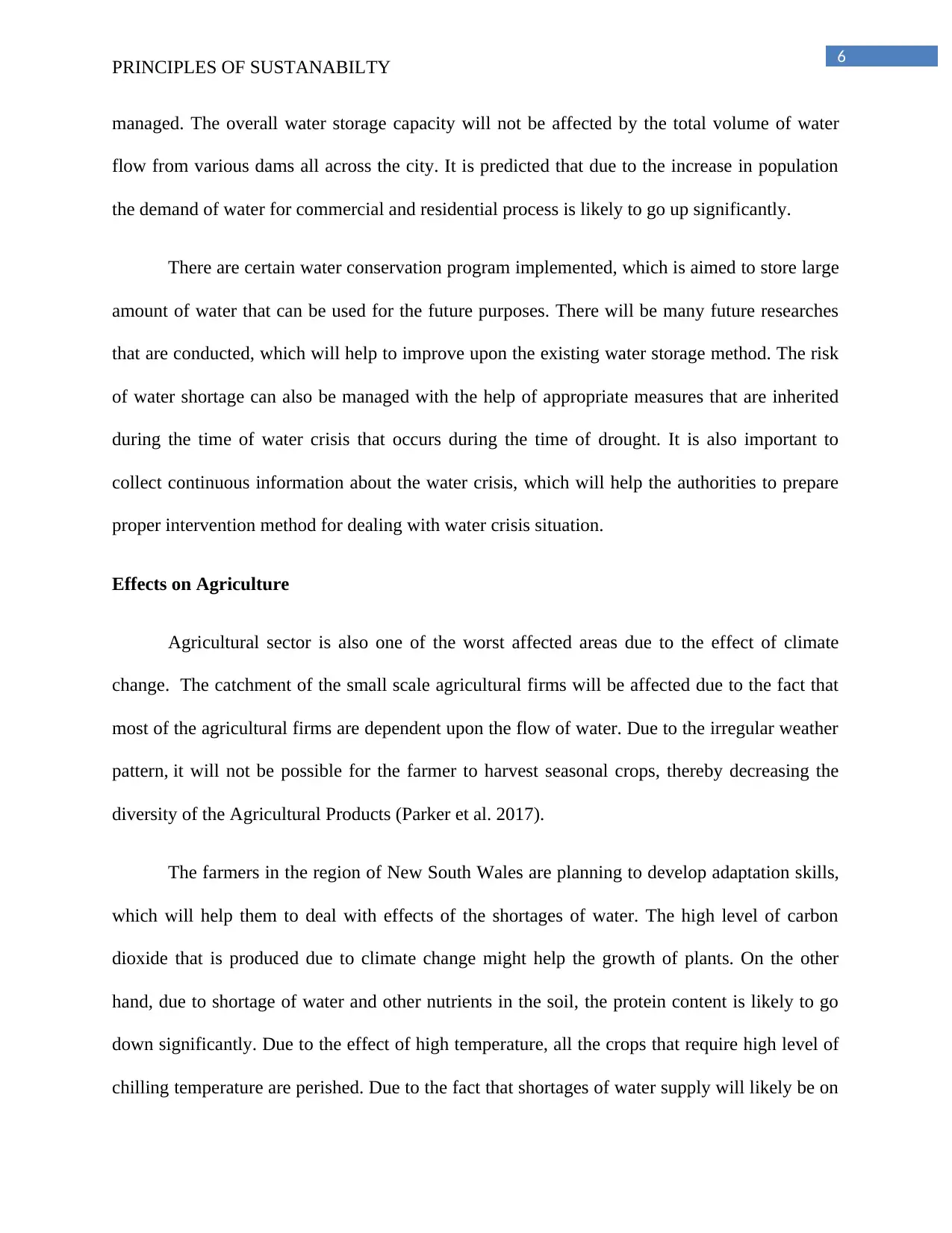
6
PRINCIPLES OF SUSTANABILTY
managed. The overall water storage capacity will not be affected by the total volume of water
flow from various dams all across the city. It is predicted that due to the increase in population
the demand of water for commercial and residential process is likely to go up significantly.
There are certain water conservation program implemented, which is aimed to store large
amount of water that can be used for the future purposes. There will be many future researches
that are conducted, which will help to improve upon the existing water storage method. The risk
of water shortage can also be managed with the help of appropriate measures that are inherited
during the time of water crisis that occurs during the time of drought. It is also important to
collect continuous information about the water crisis, which will help the authorities to prepare
proper intervention method for dealing with water crisis situation.
Effects on Agriculture
Agricultural sector is also one of the worst affected areas due to the effect of climate
change. The catchment of the small scale agricultural firms will be affected due to the fact that
most of the agricultural firms are dependent upon the flow of water. Due to the irregular weather
pattern, it will not be possible for the farmer to harvest seasonal crops, thereby decreasing the
diversity of the Agricultural Products (Parker et al. 2017).
The farmers in the region of New South Wales are planning to develop adaptation skills,
which will help them to deal with effects of the shortages of water. The high level of carbon
dioxide that is produced due to climate change might help the growth of plants. On the other
hand, due to shortage of water and other nutrients in the soil, the protein content is likely to go
down significantly. Due to the effect of high temperature, all the crops that require high level of
chilling temperature are perished. Due to the fact that shortages of water supply will likely be on
PRINCIPLES OF SUSTANABILTY
managed. The overall water storage capacity will not be affected by the total volume of water
flow from various dams all across the city. It is predicted that due to the increase in population
the demand of water for commercial and residential process is likely to go up significantly.
There are certain water conservation program implemented, which is aimed to store large
amount of water that can be used for the future purposes. There will be many future researches
that are conducted, which will help to improve upon the existing water storage method. The risk
of water shortage can also be managed with the help of appropriate measures that are inherited
during the time of water crisis that occurs during the time of drought. It is also important to
collect continuous information about the water crisis, which will help the authorities to prepare
proper intervention method for dealing with water crisis situation.
Effects on Agriculture
Agricultural sector is also one of the worst affected areas due to the effect of climate
change. The catchment of the small scale agricultural firms will be affected due to the fact that
most of the agricultural firms are dependent upon the flow of water. Due to the irregular weather
pattern, it will not be possible for the farmer to harvest seasonal crops, thereby decreasing the
diversity of the Agricultural Products (Parker et al. 2017).
The farmers in the region of New South Wales are planning to develop adaptation skills,
which will help them to deal with effects of the shortages of water. The high level of carbon
dioxide that is produced due to climate change might help the growth of plants. On the other
hand, due to shortage of water and other nutrients in the soil, the protein content is likely to go
down significantly. Due to the effect of high temperature, all the crops that require high level of
chilling temperature are perished. Due to the fact that shortages of water supply will likely be on
Paraphrase This Document
Need a fresh take? Get an instant paraphrase of this document with our AI Paraphraser
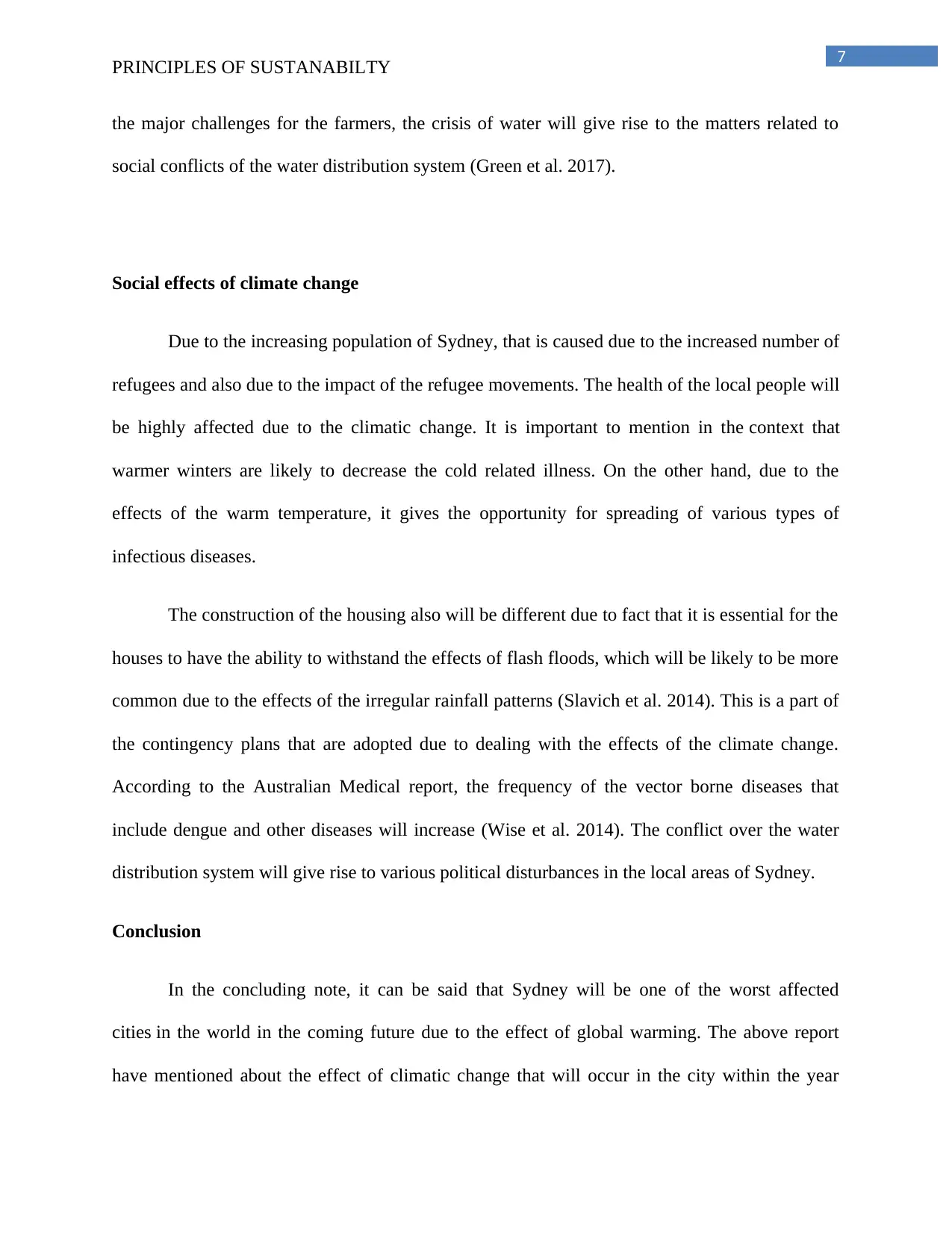
7
PRINCIPLES OF SUSTANABILTY
the major challenges for the farmers, the crisis of water will give rise to the matters related to
social conflicts of the water distribution system (Green et al. 2017).
Social effects of climate change
Due to the increasing population of Sydney, that is caused due to the increased number of
refugees and also due to the impact of the refugee movements. The health of the local people will
be highly affected due to the climatic change. It is important to mention in the context that
warmer winters are likely to decrease the cold related illness. On the other hand, due to the
effects of the warm temperature, it gives the opportunity for spreading of various types of
infectious diseases.
The construction of the housing also will be different due to fact that it is essential for the
houses to have the ability to withstand the effects of flash floods, which will be likely to be more
common due to the effects of the irregular rainfall patterns (Slavich et al. 2014). This is a part of
the contingency plans that are adopted due to dealing with the effects of the climate change.
According to the Australian Medical report, the frequency of the vector borne diseases that
include dengue and other diseases will increase (Wise et al. 2014). The conflict over the water
distribution system will give rise to various political disturbances in the local areas of Sydney.
Conclusion
In the concluding note, it can be said that Sydney will be one of the worst affected
cities in the world in the coming future due to the effect of global warming. The above report
have mentioned about the effect of climatic change that will occur in the city within the year
PRINCIPLES OF SUSTANABILTY
the major challenges for the farmers, the crisis of water will give rise to the matters related to
social conflicts of the water distribution system (Green et al. 2017).
Social effects of climate change
Due to the increasing population of Sydney, that is caused due to the increased number of
refugees and also due to the impact of the refugee movements. The health of the local people will
be highly affected due to the climatic change. It is important to mention in the context that
warmer winters are likely to decrease the cold related illness. On the other hand, due to the
effects of the warm temperature, it gives the opportunity for spreading of various types of
infectious diseases.
The construction of the housing also will be different due to fact that it is essential for the
houses to have the ability to withstand the effects of flash floods, which will be likely to be more
common due to the effects of the irregular rainfall patterns (Slavich et al. 2014). This is a part of
the contingency plans that are adopted due to dealing with the effects of the climate change.
According to the Australian Medical report, the frequency of the vector borne diseases that
include dengue and other diseases will increase (Wise et al. 2014). The conflict over the water
distribution system will give rise to various political disturbances in the local areas of Sydney.
Conclusion
In the concluding note, it can be said that Sydney will be one of the worst affected
cities in the world in the coming future due to the effect of global warming. The above report
have mentioned about the effect of climatic change that will occur in the city within the year
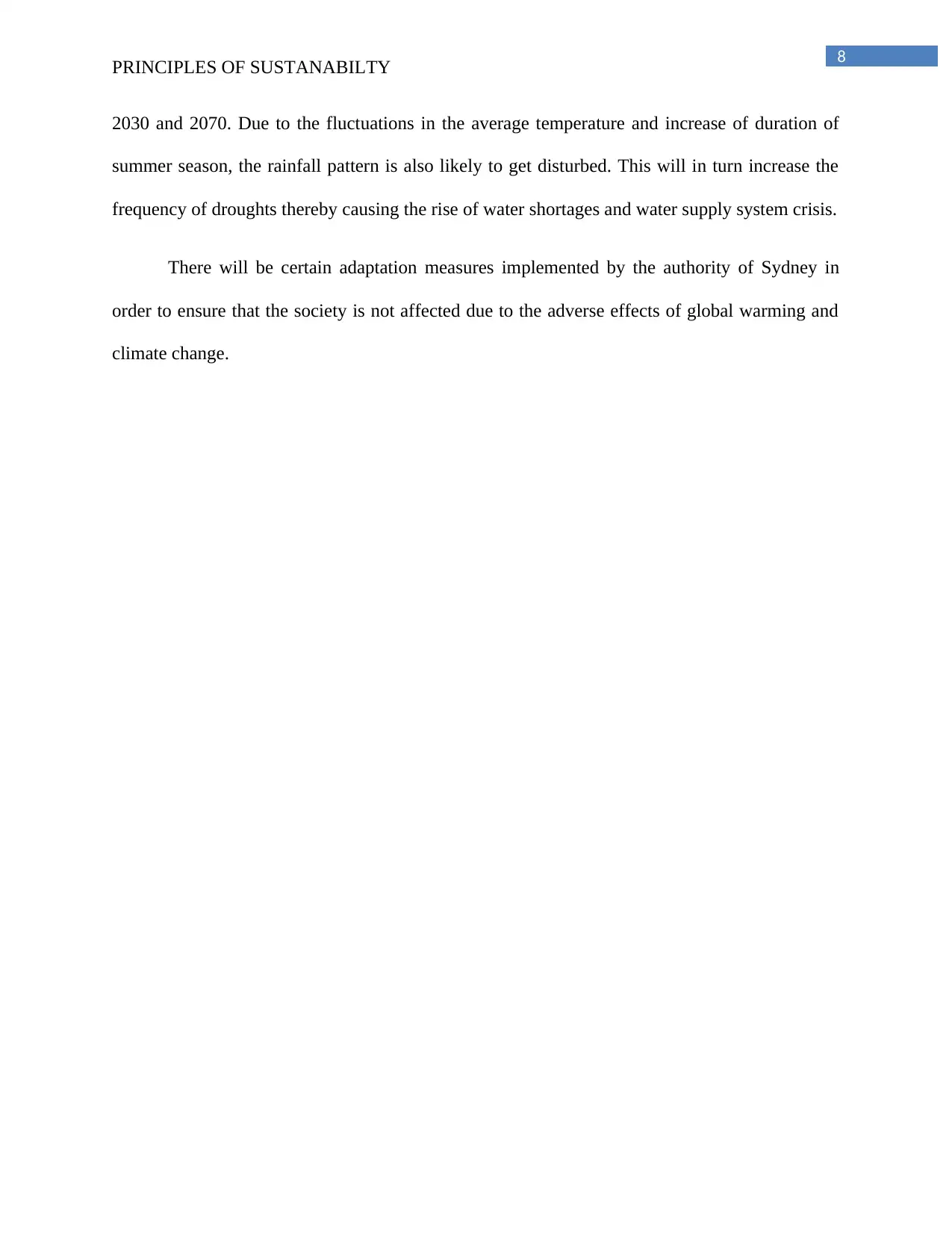
8
PRINCIPLES OF SUSTANABILTY
2030 and 2070. Due to the fluctuations in the average temperature and increase of duration of
summer season, the rainfall pattern is also likely to get disturbed. This will in turn increase the
frequency of droughts thereby causing the rise of water shortages and water supply system crisis.
There will be certain adaptation measures implemented by the authority of Sydney in
order to ensure that the society is not affected due to the adverse effects of global warming and
climate change.
PRINCIPLES OF SUSTANABILTY
2030 and 2070. Due to the fluctuations in the average temperature and increase of duration of
summer season, the rainfall pattern is also likely to get disturbed. This will in turn increase the
frequency of droughts thereby causing the rise of water shortages and water supply system crisis.
There will be certain adaptation measures implemented by the authority of Sydney in
order to ensure that the society is not affected due to the adverse effects of global warming and
climate change.
⊘ This is a preview!⊘
Do you want full access?
Subscribe today to unlock all pages.

Trusted by 1+ million students worldwide
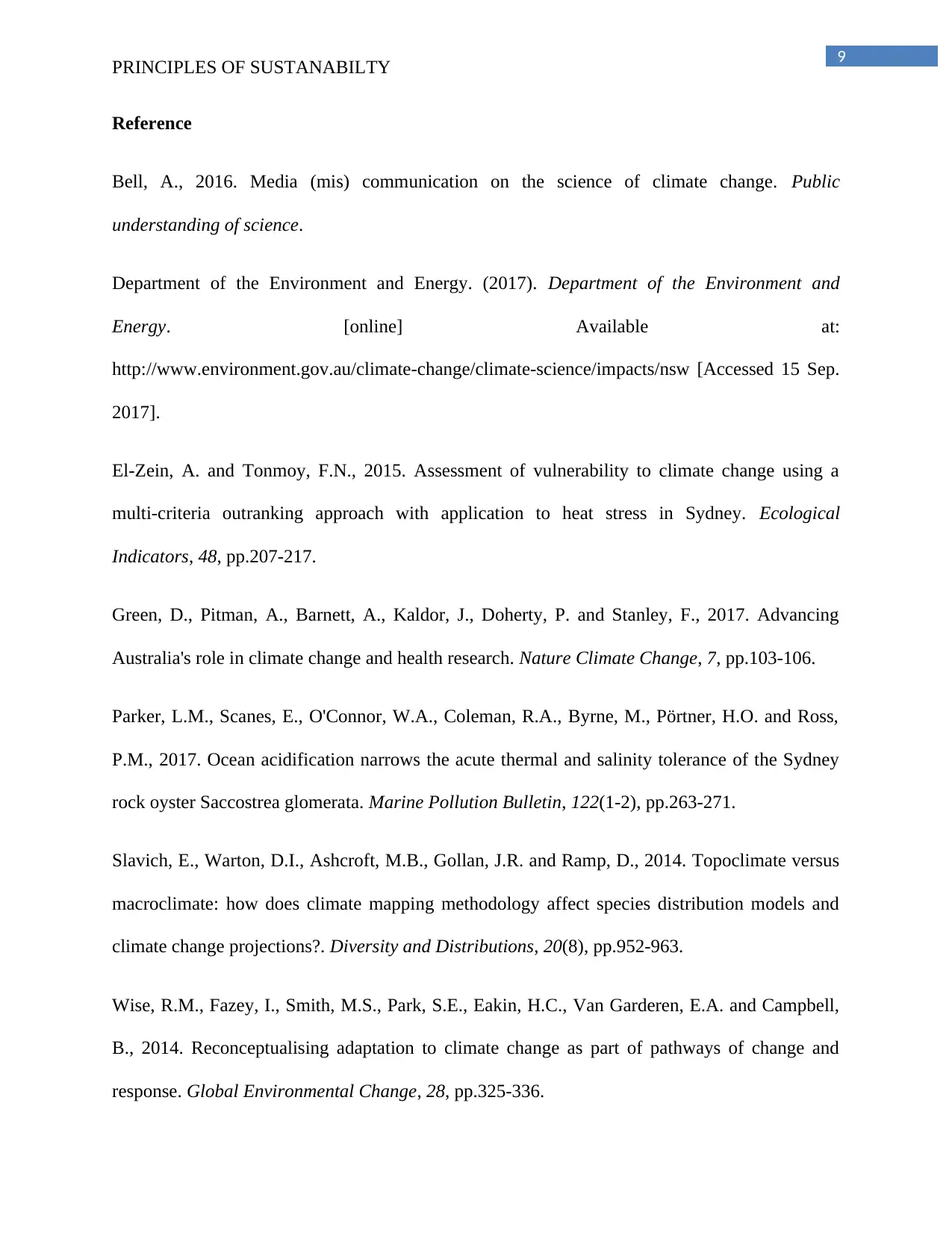
9
PRINCIPLES OF SUSTANABILTY
Reference
Bell, A., 2016. Media (mis) communication on the science of climate change. Public
understanding of science.
Department of the Environment and Energy. (2017). Department of the Environment and
Energy. [online] Available at:
http://www.environment.gov.au/climate-change/climate-science/impacts/nsw [Accessed 15 Sep.
2017].
El-Zein, A. and Tonmoy, F.N., 2015. Assessment of vulnerability to climate change using a
multi-criteria outranking approach with application to heat stress in Sydney. Ecological
Indicators, 48, pp.207-217.
Green, D., Pitman, A., Barnett, A., Kaldor, J., Doherty, P. and Stanley, F., 2017. Advancing
Australia's role in climate change and health research. Nature Climate Change, 7, pp.103-106.
Parker, L.M., Scanes, E., O'Connor, W.A., Coleman, R.A., Byrne, M., Pörtner, H.O. and Ross,
P.M., 2017. Ocean acidification narrows the acute thermal and salinity tolerance of the Sydney
rock oyster Saccostrea glomerata. Marine Pollution Bulletin, 122(1-2), pp.263-271.
Slavich, E., Warton, D.I., Ashcroft, M.B., Gollan, J.R. and Ramp, D., 2014. Topoclimate versus
macroclimate: how does climate mapping methodology affect species distribution models and
climate change projections?. Diversity and Distributions, 20(8), pp.952-963.
Wise, R.M., Fazey, I., Smith, M.S., Park, S.E., Eakin, H.C., Van Garderen, E.A. and Campbell,
B., 2014. Reconceptualising adaptation to climate change as part of pathways of change and
response. Global Environmental Change, 28, pp.325-336.
PRINCIPLES OF SUSTANABILTY
Reference
Bell, A., 2016. Media (mis) communication on the science of climate change. Public
understanding of science.
Department of the Environment and Energy. (2017). Department of the Environment and
Energy. [online] Available at:
http://www.environment.gov.au/climate-change/climate-science/impacts/nsw [Accessed 15 Sep.
2017].
El-Zein, A. and Tonmoy, F.N., 2015. Assessment of vulnerability to climate change using a
multi-criteria outranking approach with application to heat stress in Sydney. Ecological
Indicators, 48, pp.207-217.
Green, D., Pitman, A., Barnett, A., Kaldor, J., Doherty, P. and Stanley, F., 2017. Advancing
Australia's role in climate change and health research. Nature Climate Change, 7, pp.103-106.
Parker, L.M., Scanes, E., O'Connor, W.A., Coleman, R.A., Byrne, M., Pörtner, H.O. and Ross,
P.M., 2017. Ocean acidification narrows the acute thermal and salinity tolerance of the Sydney
rock oyster Saccostrea glomerata. Marine Pollution Bulletin, 122(1-2), pp.263-271.
Slavich, E., Warton, D.I., Ashcroft, M.B., Gollan, J.R. and Ramp, D., 2014. Topoclimate versus
macroclimate: how does climate mapping methodology affect species distribution models and
climate change projections?. Diversity and Distributions, 20(8), pp.952-963.
Wise, R.M., Fazey, I., Smith, M.S., Park, S.E., Eakin, H.C., Van Garderen, E.A. and Campbell,
B., 2014. Reconceptualising adaptation to climate change as part of pathways of change and
response. Global Environmental Change, 28, pp.325-336.
Paraphrase This Document
Need a fresh take? Get an instant paraphrase of this document with our AI Paraphraser

10
PRINCIPLES OF SUSTANABILTY
PRINCIPLES OF SUSTANABILTY
1 out of 11
Related Documents
Your All-in-One AI-Powered Toolkit for Academic Success.
+13062052269
info@desklib.com
Available 24*7 on WhatsApp / Email
![[object Object]](/_next/static/media/star-bottom.7253800d.svg)
Unlock your academic potential
Copyright © 2020–2025 A2Z Services. All Rights Reserved. Developed and managed by ZUCOL.




